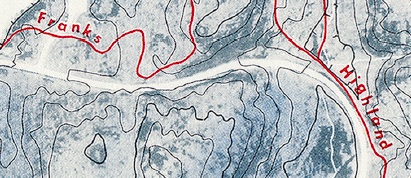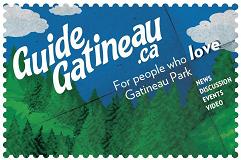 After a comment I got saying that ski trail reports weren’t updated unless there had been grooming, I asked the Gatineau Park how they managed their ski trail reporting. Even after several conversations I somehow still felt I didn’t completely understand it so it’s no wonder that the average Park user isn’t sure.
After a comment I got saying that ski trail reports weren’t updated unless there had been grooming, I asked the Gatineau Park how they managed their ski trail reporting. Even after several conversations I somehow still felt I didn’t completely understand it so it’s no wonder that the average Park user isn’t sure.
According to what I was told, in an ideal world this is how it would work. The grooming equipment is deployed at night and when the people who run the groomers are finished they submit a report in the form of a matrix, based on which trails they’ve groomed and how they feel the conditions were. The staff at the visitor centre uses this information to update the NCC website usually before 9am.
During the week there are four ski patrollers roaming the park, two in the southern section, two in the northern section. The patrollers are in contact with HQ off and on throughout their ski day and based on this communication the website is often updated twice more during the day, this time based on the patrollers’ skiing experience. Again a sort of matrix of trails, conditions and how recently the trail has been seen are delivered to the communications staff who use the info to update the website.
Weekends the numbers of patrollers are higher when volunteers join the effort.
So much for the ideal scenario. I asked why groomers are sometimes seen during the day if they are supposed to do their work at night. Certainly this is one of the main criticisms I’ve heard from those who understand grooming, that the snow needs time to set up before ski traffic, so grooming at night serves the purpose because there are few skiers out and the colder temperatures allow the trail to set before skiers arrive in the morning. These days there are many skiers into the evening so I assume “grooming at night” must mean late at night or very early in the morning.
It seems that the big machines haven’t even been out of the shed this season because the snow base is too shallow. Grooming done by snowmobiles is restricted to daylight hours to prevent a machine failure from stranding a worker in the woods when there are few staff around to save them.
This still left me confused because I felt sure I’d seen evidence of grooming by something bigger than a snowmobile midmorning on Tuesday. But I could tell the NCC staff weren’t lying to me, there must be more subtlety to this.
 An NCC provided image showing snow & ice depth of less than 14cm at P8.
An NCC provided image showing snow & ice depth of less than 14cm at P8.
 An NCC provided image showing track depth of 10cm.
An NCC provided image showing track depth of 10cm.
I was provided with these photos showing that the snow depth is pretty scant and the groomer track bars cut pretty deep. The 15cm of packed snow the NCC wants is counted not from the pavement or ground up, but from the top of the ice that’s currently underlying the snow. I see that since my query the NCC trail conditions page has gotten more specific about required snow depth and whether that includes ice.
When the snow is deep enough (and heaven send it soon) I was told that the groomers were deployed opportunistically based on recent snowfall and anticipated weather over the coming hours. I guess it’s a judgement call as to when the best time to groom is.
The language used on the NCC website is undergoing refinement. On several days the website was reporting that some trails had been worked with machines. It turns out that the work done was chiefly compacting with snowmobiles. Tracksetting I’m told can be done with snowmobiles but isn’t too effective.
I was also pointed at a FAQ page on the NCC website that talks about grooming and trail condition reporting. There it says that grooming ideally occurs 3 or 4 times a week but that there are plenty of times when grooming can’t happen depending on conditions. Most recently the underlying ice layer beneath the snow caused a risk to the grooming machines on some of the steeper hills. As it was explained to me, on a trail like Ridge Road at a place like Booth Hill or Khyber Pass, if one of the big machines gets into trouble, you can’t back it up, you can’t turn it around, and if it gets damaged the repair bills are big.
So this post has wandered off topic from how conditions are reported to how grooming is done. And in both cases there seems still some mystery to the process for me. I’m sure that these topics will come in for some discussion at the roundtable.These are the points of greatest concern as expressed by survey respondents and also points for which NCC staff are feeling some heat. I hope that all sides can be in listening mode. A better understanding of each other’s perspective might be the only way to improve this point of friction.
Or And we could get a big dump of snow.


 The cards that GuideGatineau has begun distributing to promote the website are considered to be highly environmentally responsible due to the fact that the paper used is 100% recycled and is produced using energy from biofuels plus the ink is vegetable based.
The cards that GuideGatineau has begun distributing to promote the website are considered to be highly environmentally responsible due to the fact that the paper used is 100% recycled and is produced using energy from biofuels plus the ink is vegetable based.
Any comments from the NCC on how the new “rounded” trail renovations on Ridge road (particularly Khyber Pass) affect the amount of snow required before the big machines can come in?
I like the photos and your explanation. I give credit to the Park for trying to explain their problems.
Pisten Bully 100 has a continuous rubber track (Flexmobile 150) that has a track depth of 6.8 cm. Their winter steel tracks (Flexmobile 150 k) have a 7.5 cm track depth. I would assume Bombardier has a similar product.
I seem to recall a conversation a few years ago with the Park about their forecasts for grooming in a low snow environment, which I believe was one of the reasons for renovating Burma. To permit low snow depth grooming.
If this is the reality, it is a bit of a mystery as to why the big groomers are not equipped with the appropriate tracks.
Yes, the base is thin but that’s not all that unbelievable in Ottawa. But that it seems to pose such a problem for the current groomers it unbelievable.
Under Lafleur the parkways were groomed using the rubber tracks Kevin mentioned to allow good grooming in low snow conditions. Aside from parkways I believe Ridge Rd from the top pf Penguin to Champlain Lookout was also groomable this way.
>> Tracksetting I’m told can be done with snowmobiles but isn’t too effective.
Also, this statement is bogus. Most ski clubs in Canada use snowmobiles with grooming attachments to set excellent classic tracks. (TiddTech, Ginzu Groomer, etc..) The trick is to pull a decent weighted attachment, and do it slowly. They are driving too quickly and using unweighted grooming attachments which are ineffective. This has really prolongues their problems in getting things in good shape, and probably had angry mobs pounding on their doors.
Demsis obviously doesn’t own either rubber tracks or proper tracksetting equipment for snow machines. Even though we’ve been told by the NCC many times now that the same guys are doing the actual grooming and no expertise was lost its obvious some has or they would be doing better.
To compound the issues the snow accumulation is measured predominately at the P8 groomer shed. Anyone who skis in the park knows the difference in snow that falls above P10 vs P8. I have the RFP (request for proposal) for grooming in Gatineau Park. It was posted on the XC Ottawa site. Listed in 5.7.1 the contractor WILL provide at least 1 rubber track groomer. So the nice pics from the NCC are just that nice pics.
Good catch Ian! There are two very relevant sections below.
Read the RFP at – http://www.xcottawa.ca/articles.php?id=1013
5.1.5 d) d) The Contractor is expected to be prepared to deal with difficult winter climate conditions. Abrupt weather changes could result in precipitation in the form of rain and/ or freezing rain, or sharp drops in temperature followed by milder weather.These variations cause considerable damage to the skiable surfaces of the trails, which must be returned to skiable condition as quickly as possible.
5.7.1 Machines, equipment supplies. The contractor will provide:
Motorized equipment to include the following:
a) For maintenance of primary and secondary ski trails, industrial grooming machines specially designed for the cross-country ski industry, equipped with multi-position blades and variable-width snow tillers, as well as track setters. At least one of these grooming machines must have the capacity to be equipped with smooth rubber tracks, without metallic adhesion feature, in order to be operational when the first ten (10) centimetres of snow are on the ground.